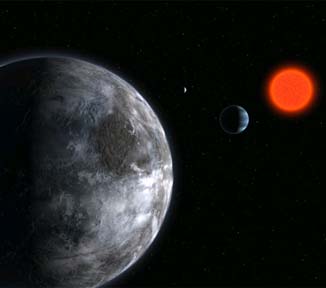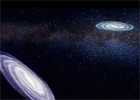

The vastness of the Universe is unimaginable, a massive expanse containing galaxies, stars, planets, and other fascinating objects. Our sun is just one of 200 billion stars in our galaxy, and our home galaxy, the Milky Way, is just one of over 100 billion galaxies. The Universe is large, the distances involved are difficult for us to comprehend, even one of our nearest galactic neighbors, Andromeda (picture left), is 2.5 million light years away, a modern day spacecraft would have to travel for around 30 billion years to reach it.
Some of the furthest galaxies exist over 10 billion light years from Earth.
Within these galaxies stars are born in vast clouds of gas and dust called nebulae. These clouds come in many shapes, colors and sizes making them some of the most spectacular sites in the Universe. They also provide an environment where new stars are created, when these stars die the material they release will go on to form new nebulae in an almost perpetual cycle.
The stars light up the Universe and in our case has brought life to our planet. Our sun is a main sequence star, meaning that it is fusing hydrogen in its core which creates vast amounts of energy. Stars spend most of their life in this state but when this sequence is over the results can often be extremely violent. Supernovas occur when large stars come
to the end of their life cycle, the star explodes releasing more energy then the sun will create in its entire 10 billion year existence.
There are around 200 billion stars in our galaxy and we are now discovering that orbiting around many of these stars are planets and planetary systems. Planets which exist outside our solar system are called extrasolar planets or exoplanets. The hunt for exoplanets is in its infancy but almost 1,000 have already been discovered, it seems its only a matter of time before another Earth like world is found. It's becoming apparent that our solar system is not unique and there could possibly be billions of habitable worlds in our galaxy alone.
The ancients believed that Earth was at the center of our Universe, but now we realise that we live on a small and possibly insignificant planet. We are beginning to understand that our environment doesn’t end at the outer atmosphere of our planet, it extends far beyond. When you look at the stars in the night sky you are looking into the past, the light from some of these stars can take thousands of years to reach us on Earth. With the right equipment you can see millions and even billions of years of history, we can even build a picture of what the Universe looked like just 400,000 years after the Big Bang. The mysteries of the Universe are beginning to unravel as new technology gives us a greater understanding of how it began, how it will evolve and how it will eventually end.
Birth of the Universe - Big Bang Theory
Before the Universe existed there was no space, time or matter, then 13.7 billion years ago an incredibly hot single point smaller than a subatomic particle containing all the matter in the Universe began expanding at an unimaginable rate creating space and time in a trillionth of a second. After this point the Universe continued to expand but at a much slower rate.
For thousands of years after the Big Bang the Universe, much smaller than it is today, was a super heated ball of plasma reaching temperatures of 300 million C (572 million F). After 400,000 years the Universe had cooled down to 3000C (5400F) allowing hydrogen and helium nuclei to form atoms, at this point the Universe was around one thousandth the size it is now and resembled a huge glowing star. We know that ancient light from this period has been stretched by the universe expanding space as it is no longer visible, it has been stretched beyond visible light into the microwave and radio parts of the spectrum. Some of the static you hear today when tuning your radio are echoes of this ancient light, known as the Cosmic Microwave Background, or CMB.
The image above is a CMB temperature map of the early Universe.
Between half a billion and a billion years after the Big Bang the Universe had grown to around one fifth the size it is now, it began to darken and cool down to just a few degrees above absolute zero allowing denser areas to begin collapsing under the force of gravity, leading to the formation of the first stars and cores of galaxies. Over the next 12.5 billion years the Universe filled with billions of galaxies each containing billions of stars and continues to expand.
Dark Matter & Dark Energy
Dark Matter
Many consider the Universe to be made up of galaxies, stars, planets and moons, the visible and directly detectable objects and particles that we can observe. This in fact is incorrect, visible matter only accounts for around 4% of the Universe. Scientists have discovered that there is a different type of matter called Dark Matter that is far more prevalent in the Universe, binding stars and galaxies together, making up around 23% of the Universe.
As its name suggests Dark Matter is dark and doesn’t interact with normal matter, billions of these particles could be streaming through your body right now and you wouldn’t know, in fact no Dark Matter has ever been directly detected. However scientists know that Dark Matter exists by observing how galaxies behave. Imagine that the solar system is a galaxy, something that is close to the center, for example Mercury, orbits very quickly whereas something that is far from the center, for example Pluto, orbits much more slowly. This is not the case with galaxies, everything in a galaxy rotates at a constant speed, meaning that something that is close to the center rotates at the same speed as something far from the center. Galaxies are also rotating at greater speeds than their mass would allow for, this cannot be explained without a far greater mass being involved. Scientists believe there is a halo of invisible Dark Matter around a galaxy (image above) that keeps everything together and rotating at a constant speed.
Dark Energy
Up until the late 20th century it was thought that the rate the Universe was expanding must be slowing down due to the attractive forces of gravity. Then in 1998, due to observations by the Hubble Telescope it was discovered that the Universe is actually expanding quicker now than it was in the distant past. This unexpected discovery shook the world of science as they tried to figure out what was causing this accelerated expansion.
The solution was Dark Energy, an unknown property in the Universe that was affecting its expansion, creating space and sending galaxies away from each other. It is thought that around 73% of the Universe is made up of Dark Energy and is the dominant force, but we don’t actually know what it is. Even though we know it is there and how it affects the Universe it is still in essence a complete mystery.
The End of the Universe
Due to the passage of time everything has a lifespan, planets, stars and galaxies will all eventually cease to exist and the Universe and time itself will come to an end. As the Universe expands matter becomes more dispersed, the gases and material that make up stars will be scattered over larger distances, areas in the Universe that will have enough density to produce star forming regions will become less and less until eventually no new stars will be born.
By this time all the large stars and smaller sun like stars will be gone, all that will be left will be their burnt out remnants in the form of black holes and black dwarfs. The only stars that will remain will be the Red Dwarfs, small dim stars that burn their fuel at a very slow rate allowing them to exist for trillions of years. Any intelligent life that is lucky enough to be on a planet that orbits a Red Dwarf will look up at a black night sky, void of any bright points of light.
These Red Dwarfs too will eventually burn themselves out until only their core remains in the form of a faintly glowing ember known as a White Dwarf (picture left), these will be the only tiny points of light left in the Universe. The Universe will exist in this state for trillions of years, but even the small amount of light given off by these White Dwarfs will eventually fade to nothing as any remaining heat disappears. It is now a Black Dwarf, an incredibly dense object made from the cold ashes of a long dead star. These too will be broken down and dispersed until eventually absolutely no matter will remain in the Universe, not even a single atom. The Universe will be a cold, empty unchanging void as time itself will come to an end.
This can seem like a very depressing future but the good news for us is that it won’t happen for a very, very long time. The Universe will continue to form new stars and galaxies for trillions of years, if you consider that at the moment it is only 13.7 billion years old you begin to realise that the Universe is just in its infancy, a baby if you like. Its future in a sense has just begun.
Universe Images
Surface of a Blue Giant star

Supernova explosion
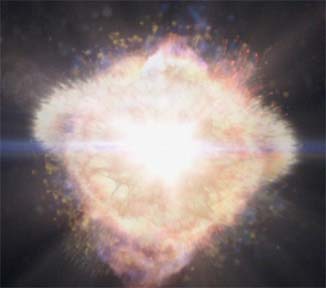
Neutron star
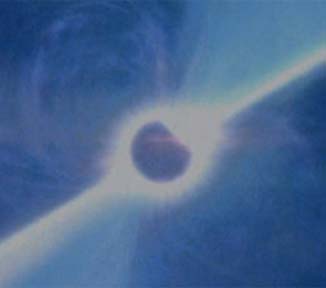
Quasar
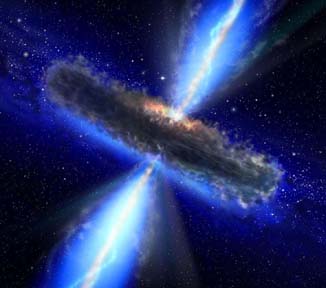
Pillars of Creation

Exoplanet Gliese 581d
